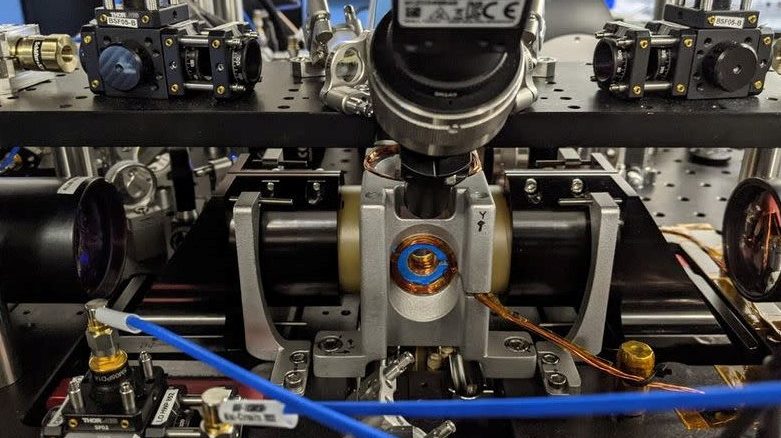
There are multiple ways of building a quantum computer, from superconducting and photonics to topological and ion trap, many backed by such big names as IBM, Google, Microsoft and Honeywell. However, ColdQuanta is betting that a modality that its founders and engineers have been working on for 15 years – cold atom – will establish itself as a method that will establish itself as quantum computing moves from a developing technology to an established global market.
“When you think about quantum computing, you read a lot about the superconducting,” Paul Lipman, who joined ColdQuanta in April as its chief commercial officer and is now its president of quantum computing, tells The Next Platform. “Cold atom is kind of the newest of the quantum computing modalities, but we believe the one with the greatest ultimate promise for scalability.”
We detailed the technology behind the cold atom modality earlier this year, making the case that the Boulder, Colorado-based company will be one to watch in the coming years as the methods and vendors around quantum computing continue to shake out. ColdQuanta this month announced that it had developed a 100-qubit {quantum bit} computer – codenamed “Hilbert” (shown in the feature image above) – that is based on its cold atom technology and will be available later this year. The gate-based computer initially will be available via the cloud on ColdQuanta’s own platform and could become available on other public cloud providers like Amazon Web Services, Microsoft Azure and Google Cloud starting in early 2022, according to Lipman.
The 100-qubit milestone is a significant one for ColdQuanta. IBM’s “Hummingbird” quantum computer tops out at 65 qubits, although the company last year said it plans to have a 127-qubit system out in 2021 and a 433-qubit system next year. By the end of 2023, IBM expects to have a system with more than 1,000 qubits by the end of 2023.
ColdQuanta’s method works by trapping cesium atoms in a grid of laser light in a 2D array, housing it in a ultra-high vacuum cell made by the company. The cell itself can fit in the palm of a person’s hand, though the computer itself, with the various lasers and electronics, is larger, he says. By trapping the atoms with lasers, ColdQuanta is able to cool them to a sub-5 microkelvin temperature – essentially very near absolute zero. The lasers and microwave pulses are used to arrange them in a way to create the gates. Atoms also are smaller than qubits created via superconducting, which means that more can be brought together in smaller areas.
Qubits are extremely fragile and keeping them cold is crucial to keeping them from flipping from one state to another. Superconducting – one of the more popular low-density quantum computing methods being matured by IBM, Google, Rigetti and others – requires the use of large dilution refrigerators that can be as large as a room and use liquid helium to keep the qubits cold.
“We’re doing it without any cryogenic refrigeration,” Lipman says. “We’re operating at room temperature and we’re able to achieve temperatures that are a thousand times colder than the superconducting approach. This has a number of benefits. … Our qubits are literally atoms. They’re cesium atoms and every cesium atom is exactly the same. They’re nature’s qubit. There are no manufacturing defects. There are no manufacturability issues. It’s as easy for us to manufacture 100 qubits as it is to manufacture a million qubits. Manufacturability and manufacturing errors is a big issue in the superconductor space. There’s no dilution refrigerator, so we can operate with these incredibly cold temperatures without any kind of cryogenic refrigeration.”
It helps ColdQuanta address the key issues of scalability and sustainability. A million qubits – which Lipman says the industry is aiming for over the next several years – essentially can fit in an area that’s millimeters on a side. However, for companies using the superconducting method, that may require a dilution refrigerator the size of a football field – “technologies that have not yet been developed or even have a clear pathway to how they would be developed,” Lipman says.
Connectivity – connecting and entangling multiple qubits to perform algorithmic calculations – is also a key issue. Again, a qubit’s fragility can mean that noise can interfere with their operations. Eventually ColdQuanta, with its cold atom modality, will have to get to connectivity in the range of 50 to 60 qubits, compared with the single digits found in the superconducting world, he says.
For these and other reasons, ColdQuanta believes that the cold atom method will have a place in a maturing quantum computing field. The company already has seen interest from the US government, which has awarded ColdQuanta more than $30 million in R&D funding. Most recently, in April 2020, the company received a $7.4 million contract from the Defense Advanced Research Projects Agency (DARPA) develop a scalable, cold atom-based quantum computing hardware and software platform and a month later was named by DARPA as one of four organizations to work on the first phase of its Optimization with Noisy Intermediate-Scale Quantum (ONISQ) devices program aimed at advancing quantum computing.
A year earlier, DARPA, NASA and the U.S. military awarded ColdQuanta $2.8 million to further develop its cold atom technology for quantum position (including atomic clocks), quantum radio frequency detectors and quantum communications systems.
Lipman says that one reason for the continued investment by the government and support from Congress to accelerate R&D is to address the ongoing technology competition with China. It’s similar to the push by both countries to establish themselves in the exascale field. In both areas, the United States and China believe they would be at a military, technological and economic disadvantage if the other one gets a significant lead in either.
Lipman sees myriad other areas where the company’s technology could come into play.
“Cold atoms have some very compelling use cases for precision timing or precision navigation or ultra-precise RF sensing that have a range of applications in defense and intelligence,” he says. “Use cases we’ll see emerge will be in the optimization and quantum machine learning areas and those that have applicability across a range of industry verticals and also in the government area. Logistics, for example, if you think about spectrum allocation, there’s a variety of applications there. Slightly further down the line applications in quantum chemistry and material science, again, with the government applications and commercial applications.”
The ability to shrink the form factor of quantum computers that use the cold atom method also will determine how the technology can be used. Lipman describes ColdQuanta’s current computer as an “optical bench, maybe kind of a square meter,” with several racks of lasers and other equipment, with the quantum core itself being small enough to hold in a hand.
“Because the qubits themselves are in such a very small array, there’s a variety of work that we are doing to ultimately reduce the overall size of the quantum computer to the point where it could fit eventually in a 19-inch rack-mountable unit,” he says. “That’s obviously several years down the line, but when you think about the potential for applications, for a field-deployable quantum computer, that starts to open up the range of new potential applications.”
The cold atom core is robust – it’s been put into space and used at the International Space Station – which also opens an array of deployment possibilities, including in datacenters and on satellites. That said, many customers eventually will access quantum computing as a service or have quantum computers in their own datacenters as part of a hybrid environment with traditional systems.
How it all shakes out is still unclear. The quantum industry is still in what Lipman says is the first of three phases, that being market formation. There are multiple modalities and vendors, hardware and software approaches being tested and partnerships being established. There also is rising interest from large enterprises that believe quantum computing will have a transformational impact on their industries, such as financial services.
The second phase – that of early business value – will happen within the next 12 months, with clear leaders emerging and showing commercial benefits of the technology using disparate methods. There will be real business uses cases that come with associated ROI, he says. Eventually the industry will reach the third phase, where there will be an advantage to businesses using quantum computing, and the market leaders that are the first to achieve that will become massively profitable companies.
For ColdQuanta, the closest goals right now are to get Hilbert launched this year and then get to 1,000 qubits in 2024. At the same time, the company will continue to continue to increase the qubit counts and use cases. It won’t be easy but the cold atom method will give ColdQuanta an advantage, Lipman says.
“There’s a range of the challenges,” he says. “It really has to do with how do you address and manage and manipulate large numbers of qubits? It’s a very small space. The view that we have is there are a range of engineering challenges, but these are not problems [for] which we don’t have a solution. It’s a matter of time and expertise and capital to solve those problems. If you look at what some of the photonic quantum computing companies are trying to do, there’s incredible science discoveries – probably Nobel prizes that get won along that way – to get from here to practical, scalable ones.”




Be the first to comment